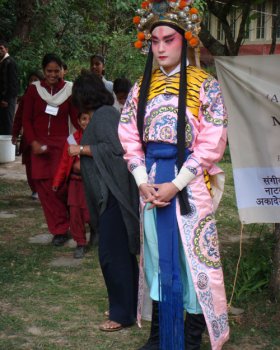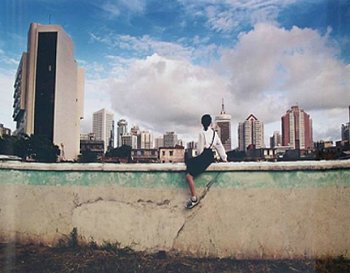
|  |

|  |
Chinese contemporary art on an upward swing - Shanta Serbjeet Singh, New Delhi e-mail: shanta.serbjeetsingh@gmail.com July 15, 2010 Mark Twain once opined: "India is the cradle of the human race, the birthplace of human speech, the mother of history, the grandmother of legend and the great grand mother of tradition." But it is China, its rise in our time, its amazing "leapfrog development" story in every sphere of human activity, that is centrestage in the minds and psyche of the world and forms the topic for discourse between any group of people in a drawing room or around a round table. All kinds of statistics will be aired, from facts like while China has achieved a target of building, on an average, 100 kilometres of highways a day, India's initial daily target of 20 kms has long since been downsized to just 4 kms a day! Even in a field like setting up DNA labs, something so important for India with its very serious security concerns, China has already DNA profiled lakhs of its citizens and set up labs that run into thousands, while India has about 28! Although both India and the United States are fully preoccupied with the threat of Islamist terrorism and the two conflicts in Pakistan and Afghanistan, there is a wide consensus among strategic thinkers in both countries that India and America's greatest challenge over the next decades will be the rise of China. With its expanding economy and formidable military growth, no one doubts that China is positioning itself to challenge the United States as the greatest international player on the world stage. And yet, on a cultural plane, Hu Shih, former Chinese ambassador to USA went on record saying, "India conquered and dominated China culturally for 20 centuries without ever having to send a single soldier across her border." The truth is that after the 100-odd years following the Opium War in 1840 when China suffered untold humiliation and insult from the big powers, it has developed a deep antagonism to other nations, especially the Western ones. And the biggest price of all has been paid by China's culture workers, its musicians and dancers, its puppeteers and its traditional opera singers. While Chinese traditional culture suffered an irreversible loss during the long decades of the Long March and Mao's cultural revolution, its artistes were punished for what were considered non-proletarian activities. Personally, I don't feel that the present governmental effort to bring these great arts back in their pristine glory have been a success. With the exception of a rare form or two such as the Kun Opera, modern Chinese performing arts are a hybrid mixture of some Orientalism and a lot of elements of Western performing arts of ballet, modern dance, proficiency on classical Western instruments such as the piano and the operatic traditions of the West. Though sorely neglected during the twentieth century in particular, Kunqu, a 600 year old art, is now beginning to enjoy a much-deserved renewal of popularity, not least among young people. In 2001, UNESCO listed Kun Opera among nineteen Masterpieces of the Oral and Intangible Heritage of Humanity. This international scale accolade has continued to add fuel to a visible upsurge of pride and interest in one of China's most precious cultural treasures. A wonderful performer of this art, Yang Yang from the Nanjing School of Kun Opera, performed at the 12th APPAN and regaled guests of this Sangeet Natak Akademi collaborated international interaction in the Himalayas.  Even a so-called minor form like photography has a big success story to tell. Contemporary Chinese photography is becoming increasingly prominent in the field of international contemporary art. In the coming months, three major US institutions - The Metropolitan Museum of Art, The Museum of Modern Art, and the J. Paul Getty Museum - will include works by Chinese contemporary photographers in major group exhibitions.   Shanta Serbjeet Singh, for twenty-five years, columnist, critic and media analyst for The Hindustan Times, The Economic Times and The Times of India, is the recipient of the Lifetime Achievement Award of the Sangeet Natak Akademi and Delhi Govt.'s Sahitya Kala Parishad for her contribution to the field of culture. She just finished her term as Vice Chairman of the SNA, is the founder-secretary of the World Culture Forum and continues as Chair of the UNESCO created NGO APPAN (The Asia-Pacific Performing Arts Network), a position to which she was appointed in 2001. Singh has authored several well-known publications such as 'Indian Dance: The Ultimate Metaphor' (published by Ravi Kumar (Paris), 'The 50th Milestone: A Feminine Critique' (Sterling Publishers, to mark India's fiftieth anniversary of Independence), 'Nanak, The Guru' (Oxford University Press) and 'America and You' (22 editions). |